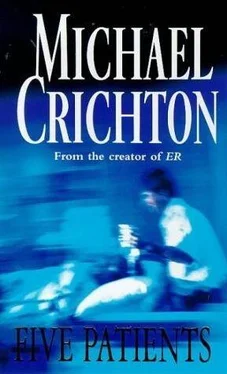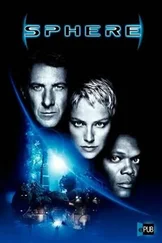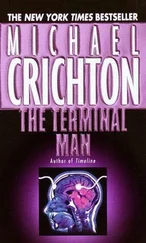Michael Crichton - Five Patients
Здесь есть возможность читать онлайн «Michael Crichton - Five Patients» весь текст электронной книги совершенно бесплатно (целиком полную версию без сокращений). В некоторых случаях можно слушать аудио, скачать через торрент в формате fb2 и присутствует краткое содержание. Жанр: Триллер, на английском языке. Описание произведения, (предисловие) а так же отзывы посетителей доступны на портале библиотеки ЛибКат.
- Название:Five Patients
- Автор:
- Жанр:
- Год:неизвестен
- ISBN:нет данных
- Рейтинг книги:5 / 5. Голосов: 1
-
Избранное:Добавить в избранное
- Отзывы:
-
Ваша оценка:
- 100
- 1
- 2
- 3
- 4
- 5
Five Patients: краткое содержание, описание и аннотация
Предлагаем к чтению аннотацию, описание, краткое содержание или предисловие (зависит от того, что написал сам автор книги «Five Patients»). Если вы не нашли необходимую информацию о книге — напишите в комментариях, мы постараемся отыскать её.
Five Patients — читать онлайн бесплатно полную книгу (весь текст) целиком
Ниже представлен текст книги, разбитый по страницам. Система сохранения места последней прочитанной страницы, позволяет с удобством читать онлайн бесплатно книгу «Five Patients», без необходимости каждый раз заново искать на чём Вы остановились. Поставьте закладку, и сможете в любой момент перейти на страницу, на которой закончили чтение.
Интервал:
Закладка:
Seen in this light, automated therapy becomes a more reasonable prospect. It will require adjustment, of course, by both doctors and patients. But that adjustment will be no more severe than in other sectors of society.
In the past fifty years, society has had to adapt to machines that do mechanical work-in essence, taking over functions of the musculoskeletal system. It is now quite accepted that almost nobody does anything "by hand" or "on foot," except for sport or pleasure. But what is coming is what Gerard Piel calls "the disemployment of the nervous system," in a manner comparable to the disemployment of the musculoskeletal system. Man has accepted the fact that there are machines superior to his body; he must now accept the fact that there are machines in many ways superior to his brain.
The image of the patient, lying alone in bed, surrounded by clicking, whirring stainless steel is certainly unnerving. It is easy to agree with the doctors who fear automation as leading to depersonalized care, and the computer, as psychologist George Miller notes, as "synonymous with mechanical depersonalization." But that is probably because we are so unfamiliar with them, and, in any event, man has found ways to personalize machines in the past-the automobile is a baroque example-and there is no reason to think he cannot do it in the future.
One example of an attempt to computerize some elements of patient therapy is the computer-assisted burns treatment project being carried out, with the Shrine Burn Institute, in Dr. G. Octo Bar-nett's Laboratory of Computer Science at the MGH. The project director, Kathleen Dwyer, notes that "there's no theoretical reason why you couldn't build a program to carry out some functions of a doctor, at least for certain kinds of patients. But, practically speaking, it's a long way off."
In trying to find out why, precisely, it is a long way off, one gets two kinds of answers. The first is that nobody is really interested in working very hard, at the moment, to duplicate a doctor on magnetic tape. The second answer is that doctors don't know themselves precisely how they operate; until doctors figure it out, no one can program a machine to carry out the same functions. The classic situation is that of the physician who enters the room of a person with normal temperature, heart rate, blood pressure, and electrocardiogram, takes one look at him and says: "He looks sick." How did the physician arrive at that conclusion? If he can't tell you the signals he used, then the programmers can't computerize them.
This situation is often held up as a kind of limit on the application of machines to medicine. How can one imitate the "unconscious" or "instinctive" or "intuitive" or "experiential" functions of a doctor? But, in fact, as Kirkland and others have pointed out, the argument is really more damaging to the reputations of physicians than machines. For, unless the doctor is flatly guessing when he says, "The patient looks sick," he is drawing a conclusion on the basis of some input, presumably visual. One need only identify that input-and then plug it into the computer. But if the input is truly unidentifiable, one must strongly suspect that the doctor is guessing or expressing a prejudice.
In any event, there is considerable interest in knowing how a doctor decides that a patient looks sick, or looks better, for, as Dr. Jerome Grossman says: "Working with computers has made us look closely at how people think."
But at the moment computer-assisted programs are all that are being used. Dwyer's program, which will be in pilot use by the end of 1970, is specifically designed to help in a major management problem-the burned pediatric patient. These young patients require close monitoring and frequent changes in therapy. This in turn produces an enormous amount of paperwork and accumulated data that is hard for a physician to summarize in his own mind simply by reading the chart. Dwyer anticipates that a computer-assisted program would "facilitate the orderly collection and retrieval of information [and] would not only improve patient care… but would also lead to the development of optimal therapeutic models and a better understanding of the disease process."
The first phase of the project will be a simple bookkeeping function: storing information about the patient and his treatment and displaying it on command on a teletype, or a cathode-ray tube (essentially, a TV screen), whenever the physician requests it. A hypothetical example of such a display is shown on the next page.
Here the computer is summarizing intravenous (Ringers) and oral fluid intake, urine output, and weight change over a five-day period. This achievement will not be very exciting to anyone who has not spent half an hour going through a patient's chart attempting to extract this information- which the computer can provide in milliseconds.
FLUID TOTALS INPUT: 1300 OUTPUT: 447 «T. CHANGE: +.8
YESTEBDAX 8/1/68
Bill 200/300 -/SO 60/126 81
10AM 800/600 100/160 76/200 81.6 800P
6111 100/2600 -/TOO ZOO/1200 7AM 72/2576 60/750 100/1300 FLUID TOTALS INPUT: 3325 OUTPUT: 1300
82 82 BT. CHANGE: +1
1/31/68 300(200)/3200 1/30/68 3000(-I/3000 1/89/68 4200 (100)/4300
1100 1000 900
B,P
But the second stage is rather different. It is called "computer-generated treatment regimen," and what it means is that the computer will itself advise future therapy, which the physician is free to accept or ignore.
Another hypothetical example, for a new patient admitted to the unit:
ADMISSION DATE T
05/08/69 ADMISSION TIMEN^ 11.22AM ADMITTING DOCTOR'S INITIALS… KRD PATIENT'S NAME… SMITH, JOHN BIRTH DATE… it/20/65 UNIT NUMBER… 1234567
THIS UNIT NUMBER IS ALREADY ASSIGNED.
TRY AGAIN OR USE TEMP. UNIT NUMBER… 123456 LOCATION… SBI WEIGHT (LB OR KG?)… 20 KG HT (IN OR CM?)… 110 IN/CM? CM^ BURN DATE T TIME SAM TOTAL PERCENT BURtT… 16
PERCENT 1ST DEGREE… 0
2ND DEGREE… 9^
2ND-3RD DEGREE… 27
BURN SURFACE COMPUTEoTo BE
0.27 SQ METERS TREATED PREVIOUS TO EW
ew therapy
N/S
. 0
ye? enter totals (ml) l!c~ringers… 200 plasma…? blood, urine.. 0~ vomitus
SUGGESTED INITIAL REPAIR AND MAINTENANCE 1440 ML RINGERS BEFORE 4.00 PM 05/08/69 RATE: 315 D/M PED (80 AD) 1640 ML RINGERS BEFORE 8.00 AM 05/09/69 RATE: 100 D/M PED
SUGGESTED INITIAL REPAIR AND MAINTENANCE 1440 ML RINGERS BEFORE 4.00 PM AT A RATE OF 310 D/M (PED)
1640 ML RINGERS BEFORE 8.00 AM ON 05/09/69 AT A RATE OF 100 D/M (PED)
Now this is not really so ominous. The suggestions for therapy are actually based on principles that come from John Crawford, chief of pediatrics at the Burns Unit. In essence, they represent (assuming no error in the program, and no variables that he would take into account but the machine does not) his therapeutic program were he personally treating the patient.
Thus the computer is at best as clever as a single clever man, and at worst considerably less astute than that one man.
Once in use, the MGH burns project will be analyzed by doctors, and adjustments made to refine the program. And as the program improves, it may become more and more difficult for a physician to ignore the computer's "advice."
Читать дальшеИнтервал:
Закладка:
Похожие книги на «Five Patients»
Представляем Вашему вниманию похожие книги на «Five Patients» списком для выбора. Мы отобрали схожую по названию и смыслу литературу в надежде предоставить читателям больше вариантов отыскать новые, интересные, ещё непрочитанные произведения.
Обсуждение, отзывы о книге «Five Patients» и просто собственные мнения читателей. Оставьте ваши комментарии, напишите, что Вы думаете о произведении, его смысле или главных героях. Укажите что конкретно понравилось, а что нет, и почему Вы так считаете.









